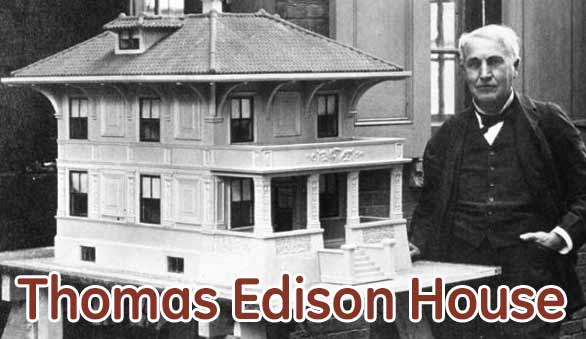A Little About the Life of Thomas Edison
In the front room of the Thomas Edison House is a chronology or timeline which illustrates the life of Edison, some of his most significant inventions, and major national and international events that occurred during this period. He witnessed and was a significant force behind many of these remarkable changes.
Thomas Alva Edison was born in 1847 in Milan, Ohio. At that time, James Polk was President and Abraham Lincoln was just contemplating running for the legislature. When Edison died in 1931, at the age of 84, Herbert Hoover was President and we were in the middle of the Great Depression. During his lifetime Edison saw the United States engaged in two major wars: the Civil War when he was a teenager, and World War I when he was an adult and appointed to assist the Secretary of the Navy. His inventions had a significant effect upon his times and permanently altered the way in which we live today. Can you imagine life without the electric light? The phonograph and all of its improvements? The motion picture?
At the age of 12, Edison began work as a "candy butcher" aboard the Grand Trunk Railroad's commuter line between Port Huron, Michigan, where we lived with his parents, and Detroit. He sold newspapers, fruit and candy to the passengers. The train left Port Huron about 7:00 in the morning and returned at 9:00 or 9:30 at night. The trip included a six hour layover in Detroit, during which time he claims to have read "the entire public library." He was an omnivorous reader and loved to experiment with chemicals and machinery. He constantly wanted to investigate how things worked and liked to see if he could make things better. On the train he was allowed a table in an empty baggage car on which to work. He even brought a broken printing press, repaired it and taught himself to print. He may have produced the first newspaper printed on a moving train. Edison began noticing a loss of hearing around this time, which increased throughout his life.
At that time, telegraph lines often ran parallel to the railroad tracks, and many of the station masters were telegraph operators. Edison was struck by the importance of telegraphy in communication. At home he rigged a makeshift telegraph line between his house and that of a friend so that they could send messages back and forth. Later he and his father would "read" the paper over the telegraph line. Soon he decided to become a real telegraph operator, and with the help of one of the station masters, he learned this skill. He became a telegrapher at the age of 15 and began working for Western Union in such places as Indianapolis, Cincinnati and Memphis. In 1866, at the age of 19, Thomas Edison came to Louisville as an employee of Western Union whose office was then located at the Southwest corner of Main and Second Street. After a brief excursion to New Orleans in August 1866, he returned to work in Louisville. He then found lodging in a shotgun duplex on East Washington Street.
Edison requested the night shift at work which allowed him plenty of time to spend at his two favorite pastimes -- reading and experimenting. However, it was the latter that eventually cost him his job. One night in 1867, he was working with a battery when he spilled sulphuric acid onto the floor. It ran between the floorboards and onto his boss' desk below. The next morning he was fired.
While this event marked the end of Thomas Edison's stay in Louisville, you can follow a chronology of his life and discover more of his remarkable achievements by visiting these sites.
